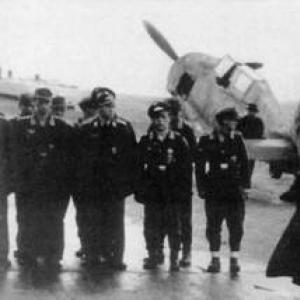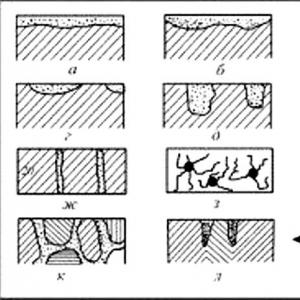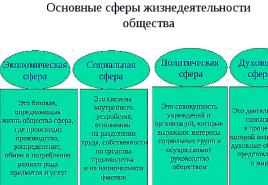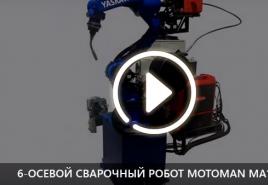Computer in English. Translation and meaning of computers in English and Russian
in physics. Used in the following bases. directions: automation of experiment and control of processes in real time (see. Experiment automation), numerical analysis, analytical calculations, computer experiment, visualization of data from a physical or computer experiment (see. Graphical representation of data), local computing, networks.
Numerical experiment physical model on a computer usually completes it theoretically. research, brought to the description of the system of a set of ur-ny or f-l. The latter in most cases can be analyzed only with the help of numerical analysis, which consists in solving these equations or calculating f-l using appropriate methods will calculate, mathematics.
Analytical calculations. Along with the enormous possibilities for the numerical analysis of problems in physics, modern. computer systems provide theoretical physicists with a wide range of analytical software systems. calculations (CAB), see, allowing you to analytically perform operations such as differentiation, integration, solving systems of equations, simplifying expressions (casting similar terms, substituting other expressions instead of a symbol or expression, etc.). As a result, the result of the calculation is a certain analytic. expression, for example, a function with an explicit dependence on its arguments. CABs are a powerful (and practically the only) tool for solving problems that require an exorbitant amount of manual labor in their analytical. solution (for example, the problem of inverting a matrix of a sufficiently high order, which are symbols or algebraic expressions), or problems that are very sensitive to the loss of accuracy in their numerical solution (for example, the problem of analyzing the stability of a plasma in an installation of the type, which reduces to the condition the existence of a zero of a certain function in a given area, the position of which is very sensitive to the loss of accuracy in numerical calculations). Of course, CABs can only solve those problems for which a clear algorithm for constructing a solution is known.
Traditions. areas of application of CAB in physics - celestial, general theory of relativity, physics of elementary particles, plasma, hydrodynamics, theory of nonlinear differentials. ur-niy, etc. One of the naib, striking results - the calculation of the contribution of three-sided diagrams in the anomalous magn. moment of the electron, which made it possible to achieve agreement between theory and experiment with an accuracy of ~ 10 -12, see.
Naib, a widespread CAB - the REDUCE system, created in the late. 1960s - early. 1970s under the leadership of E. Hearn. The first version of the system was developed for the PDP-11 mini-computer by Digital Equipment Corporation (USA). Subsequently, REDUCE became available on all bases. types of computers, including personal computers and workstations.
The operating principle of CAB REDUCE is shown in fig. 1. The REDUCE user writes tasks for specialized. language high level descriptions of analytic. calculations (REDUCE language). Actually CAB REDUCE is written in Lisp language. The user, however, does not need knowledge of Lisp, since executing a REDUCE program consists of converting (translating) the program into Lisp, executing the Lisp program by the computer, and then converting the output of the Lisp program back to REDUCE. Thus, the user communicates with the CAB only in the REDUCE language. Often issued by CAB REDUCE f-ls must be used for numerical calculation. CAB REDUCE itself is able to perform calculations with arbitrary precision, but very slowly. Therefore, f-ly is more effective for counting in the Fortran language. For this CAB REDUCE is equipped with a special option that generates the output of results in the form of a FORTRAN program.
but use the resulting f-ly for the Fortran account. For this CAB REDUCE is equipped with a special option that generates the output of results in the form of a FORTRAN program.
CAB REDUCE consists of a kernel, built-in REDUCE packages that are loaded into memory the first time they are accessed, and external. packages downloaded by the user using specials. teams. There are a large number of packages available for use in various areas of physics and mathematics, to-rye can be obtained through the e-mail network.
Computer experiment (FE) consists in modeling the physical model by FE methods. system in order to study its characteristics, identify new patterns. In contrast to the numerical analysis of the model, when it is based. the research is carried out analytically, in FE a model of the system is built from first principles or using funds. laws and a small number of parameters. FE methods are divided into stochastic ones (see. Monte Carlo method) and deterministic (see. Molecular dynamics method). Progress in FE is associated with advances in technology and theory of parallel computing. The base for them is modern. multiprocessor computes, systems with parallel data processing (see. Microprocessor, processor), performance to-rykh reaches 10 9 floating operations per second; work is underway on a computer project with a capacity of 10 12 floating operations per second.
One of the main. the advantages of FE - the elimination of limitations on the models inherent in any analytical or numerical analysis. Due to the possibility of studying complex systems, FE is a kind of "standard", with which decomp. Can be compared. approximate models. On the other hand, FE also admits comparison with real experiment and, therefore, verification of the correctness of the model (Fig. 2). Finally, FE makes it possible to fill the gap between theory and real experiment. Certain quantities or dependences are impossible or difficult to measure in a real experiment, but in FE they can be easily calculated.

Figure:2. The relationship between experiment, computer experiment and theory development.
Computing networks(BC) - communication. systems allowing communication with each other of the same type or dissimilar means of computing and microprocessor technology, including decomp. types of computers, peripheral equipment (terminals, printers, plotters, external memory devices, etc.). BC are classified by geographic dimension. area (where networked equipment is located) to global and local BC.
Global BCs cover cities, provinces and regions of one or more. countries.
Local BC (LAN) integrate decomp. computers and devices within the same institution, group of laboratories or one laboratory. LAN naib. are widely used in physics in the construction of experimental automation systems and in distributed data processing systems. The latter allow, for example, to carry out processing and storage of large arrays of experiments. information separately from the place of its registration and will be preliminary. processing. Naib. developed systems of this type have been created in the centers of high energy physics, cosm. centers and centers for atomic energy (CERN, NASA, MAGATE, etc.).
A typical LAN allows you to organize the transfer of data files from one computer to another, sharing resources such as printers and memory on a magnet. disks, remote access to any computer on the network, sending e-mail (see below), downloading software over the network, etc. The latter feature allows you to use LAN computers that do not have external devices. memory for magn. carriers.
LANs are characterized by architecture (topology), physical. information transfer medium, access methods and control protocols in the network.
The architecture (topology) of a LAN determines the mutual placement of devices (so-called nodes in terms of LANs), united by LAN, and the method of connection between them. Main LAN architectures - bus, ring, and star (Fig. 3). Printers, modems and external devices memory for magn. disks are connected to the LAN using special. interface - a network server, which allows you to share the connected resource between network nodes. To increase the length of the LAN transmission medium, communication of the same type of LAN and LAN different types specials are applied. devices - repeaters, bridges and gateways, respectively.
Phys. LAN environment - physical transmission medium information. To implement a LAN, twisted pair, coaxial cable, fiber optic are used. cable and (radio, infrared and microwave ranges). Compare characteristics nat. LAN environments are given in table.
LAN access methods - methods of sharing a common resource of physical. transmission media between LAN nodes when receiving or transmitting data. The complexity of the problem of separating the transmission medium is that the nodes must transmit in such a way that they do not interfere with each other. Otherwise, the signals will overlap and their mutual distortion, that is, a conflict situation will arise. All methods of access to a LAN can be divided into methods used in centralized and decentralized network management. In the first case conflict situations center easily resolved. an arbiter (for example, a central processor serving the computer's data bus). Access methods in networks with decentralized control can be divided into random, token, and interval.


Random access methods are characterized by the fact that network nodes can transmit data at arbitrary times, which leads to conflicts at the same time. data transmission by two or several. knots. The distorted data is transmitted again. To reduce conflicts, a node can check for data transmission from other nodes before starting to transmit its data ("listen before you talk").
In token access methods, the right to transfer in the network passes from one node to another in the definition. sequence or priority using special. messages (markers).
The node that received the token can transmit data for a specified period. time, after which he is obliged to transfer the marker. node.
Interval access methods allow you to divide the data transmission medium between LAN nodes, providing, in the simplest case, each node with a fix. time to transfer data.
LAN control protocols. The task of transferring information from one node to another is carried out in the LAN according to the data transfer protocols. These include definitions of the data transfer format, data transfer procedures, and link control. The simplest protocols are serial and parallel exchange protocols implemented in the corresponding interfaces. Most LAN control protocols currently use the principles laid down in the High-level Data Link Control (HDLC) protocol. Data, according to this protocol, are transmitted in blocks of bytes (frames) having the format shown in Fig. 4. The transmitted data is placed in the information. frame and are accompanied by a number of fields.
Figure: 4. HDLC protocol frame format: BEG, END- header and end of frame fields; 1, 2-fields of recipient and sender addresses; 3 - control command field; 4-information data field; 5 - control field.
To determine the number of the node to which it is addressed, the recipient's address is indicated in the frame, and the sender's address is indicated to control the sender. The protocol also includes a set of channel control commands such as "channel reset", "data transfer", etc.
One of the most widespread LANs is the Ethernet LAN, developed by Xerox (USA) in 1976 for connecting personal computers. Since 1980, this LAN has been adopted as a standard by Digital Equipment Corporation, Intel, Xerox, etc. LAN Ethernet has a bus architecture, physical. transmission medium - a coaxial cable providing data transmission of 10 Mbit / s. The channel access method is random with transmission and collision checks.
E-mail (E-mail; Electronic mail. E-mail) - a system for the transmission of written correspondence on local and global BC, allows you to organize operational communication between scientists working in different. geographic features. points. Along with telephone and facsimile communication, electronic signature is becoming a standard means of information transmission. Reports at MH. scientific conferences, articles in a number of leading scientific journals are accepted by electronic means.
EDS network works trace. way. The end user has a computer (usually personal) equipped with a modem and special. a program that allows you to send messages to one of the node computers of the EDS network (located on a regional basis). Communication of the user's computer with the regional mail center is carried out via regular telephone lines using a modem. This limits the information transfer rate to 1200 ... 2400 bit / s (over long distances, in the presence of interference). The user can at any time contact ("call") from his computer to the host computer, receive messages addressed to him stored on it, and send his own.
The nodal, regional computers of the EDS network are connected, in turn, either by dedicated (non-commutated) telephone lines, or by k.-l. in another way that provides fast transfer of large amounts of information between nodes. The nodes are usually powerful workstations or mini-computers that work around the clock. According to this principle, for example, one of the naib. RELCOM EDS networks widespread in Russia. At present, there are EDS networks (Internet, Bitnet, EUnet, etc.), which actually cover the territory of all developed countries. Dec. EDS networks are interconnected through appropriate gateways - computers that are nodes simultaneously in different EDS networks.
The electronic signature is in many ways similar to the usual one: the text of the letter is entered from the keyboard or from a pre-prepared file, supplied with accompanying information (recipient and sender addresses, date of departure, etc.) and sent to the addressee. The address in the EDS network is set in different ways. networks. For example, the address "headdept. Institute, msk. Su" has the typical structure of an Internet (and RELCOM) address, in which the addressee's name (head) is indicated to the left of the sign, and his address in the network, consisting of the country code ( su), area code (msk), name. in-ta (institute) and divisions (dept). All country codes, except for the USA, consist of 2 letters (e.g. su, ru - Russia, fr - France, it - Italy, etc.). Destinations located in the United States have a 3-letter code (edu - schools, com - commercial structures, gov - government organizations, mil - military organizations, etc.).
Electronic signature networks provide, in addition to sending e-mails, teleconferencing services and the ability to use public file archives. In addition, the latest electronic signature systems allow the transmission of the so-called. multimedia mail, combining text, graphics, (sound) and facsimile information in one message.
Lit .:1) Fedorenko P. P., Introduction to computational physics, M., 1994; 2) Gould X., Tobochnik J., Computer in physics, trans. from English, hours 1-2, M., 1990; 3) Konstantinov A.B., computers in the role of a theoretician: symbolic calculations and principles of artificial intelligence in theoretical physics, in the book: Experiment on display. First steps in computational physics, M., 1989; 4) Kryukov A.P. Rodionov A. Ya., Taranov A. Yu, Shablygin E. M., Programming in the R-Lisp language, M., 1991;
5) Edneral V.F., Kryukov A.P., Rodionov A. Ya., Language of analytical computations REDUCE, M., 1989; 6) V.P. Gerdt, O. V. Tarasov, D. V. Shirkov, Analytical calculations on a computer as applied to physics and mathematics, UFN, 1980, v. 130, p. 113; 7) H ear h A.S., REDUCE User's Manual, RAND Corp .. pub. CP78, 1987, rev. 7/87; 8) Computers, models, computational experiment, M., 1988; 9) Heerman D V., Methods of computer experiment
in theoretical physics, trans. from English, M., 1990; 10) Physics Today (Special Issue on High-Performance Computing and Physics), 1993, March; 11) Myachev A.A., Stepanov V.N., Shcherbo V.K., Interfaces of data processing systems, M., 1989; 12) G and K., Introduction to local area networks, trans. from English, M., 1986; 13) Boychenko E. V., Kalfa V., Ovchinnikov V. V., Local area networks, M., 1985; 14) Zadkov V. H., Ponomarev Yu. V., Computer in experiment. Architecture and software automation systems, M., 1988; 15) Shvartsman V.O., E-mail, M., 1986; 16) P. Antonova, RELCOM Network and email, "Computer Press", 1991, vol. 10, p. 69. V. H. Zadkov.
Physical encyclopedia. In 5 volumes. - M .: Soviet encyclopedia. Chief Editor A.M. Prokhorov. 1988 .
Synonyms:
See what a "computer" is in other dictionaries:
Neism .; g. [in capital letters] Electronic calculating machine... Work on a computer. Computer of the fifth generation. * * * For computers, see Electronic computer. * * * COMPUTER COMPUTER, see. Electronic computer (see. ELECTRONIC COMPUTER) ... encyclopedic Dictionary
Electronic computer, computer Dictionary of Russian synonyms. Computer electronic computing machine, computer Dictionary of synonyms of the Russian language. Practical guide. M .: Russian language. Z.E. Aleksandrova. 2011 ... Synonym dictionary
Computer translation and meaning in English and Russian
transcription, transcription: [ (electronic computer) ]
(electronic) computer
English-Russian-English dictionary of general vocabulary, a collection of best dictionaries. English-Russian-English dictionary of general lexis, the collection of the best dictionaries. 2012
→ English-Russian-English vocabularies → English-Russian-English dictionary of general lexis, the collection of the best dictionaries
More meanings of the word and the translation of a computer from English into Russian in English-Russian dictionaries and from Russian into English in Russian-English dictionaries.
More meanings of this word and English-Russian, Russian-English translations for the word "computer" in dictionaries.
- Computer - abbrev (electronic computer), computer
Russian-English Dictionary of the Mathematical Sciences - Computer - (electronic computer) (electronic) computer abbr. from electronic computer
- Computer - women; abbr. from electronic computer
General Russian-English Dictionary - Computer - Computer
Russian Learner "s Dictionary - computer
Russian-English dictionary - Computer - (electronic computer) (electronic) computer
Russian-English Smirnitsky abbreviations dictionary - Mainframe computers - computer use of mainframes: mainframe computing
Russian-English Edic - Computer - calculation device, engine
Russian-English Dictionary of Mechanical Engineering and Industrial Automation - Computer - (electronic computer) (electronic) computer
Russian-English Dictionary - QD - Computer - see put into computer; computer-controlled
Russian-English scientific and technical translator dictionary - Computer - electronic computer
Russian-English explanatory dictionary of terms and abbreviations on BT, Internet and programming - computer
- Computer - wives abbr. from electronic computer (electronic) computer (electronic) computer
Large Russian-English Dictionary - Computer - computer pc
Russian-English Dictionary Socrates - MAINFRAME - 1) (universal) (computing) machine (as opposed to mini-machines and small commercial machines) 2) basic, original, fundamental ∙ hign-end mainframe low-end ...
- DIAL-UP - I (disk) dialing (commands), code call, number call (to establish communication with a computer using a code dialer) II dial-up (eg ...
Large English-Russian Dictionary - COMPUTER
Large English-Russian Dictionary - SLAVE COMPUTER is a backup computer. A computer that performs the same operations as the main computer and takes control immediately after a failure in the main computer. subordinate ...
Tiger English-Russian dictionary - HOST COMPUTER - main computer, geomputer. in a multi-machine complex - a computer on which the main information processing is performed. working computer. in computer networks - ...
Tiger English-Russian dictionary - COMPUTER GENERATION - computer generation. in the development of computer technology, five generations are distinguished, characterized by architecture, element base and method of using computers. the first generation of computers ...
Tiger English-Russian dictionary - COMPUTER GENERATION - computer generation. in the development of computer technology, five generations are distinguished, characterized by architecture, element base and method of using computers. the first generation of computers (1940-195 - ...
English-Russian additional dictionary - WORKSTATION - 1) automated workplace, AWP. Connected to the main computer or to the computer network, a terminal or micro-computer designed to perform work ...
- SLAVE COMPUTER - 1) backup computer. A computer that performs the same operations as the main computer and takes control immediately after a failure in the main computer. ...
English-Russian dictionary on computers - MINICOMPUTER is a mini-computer. Mini-computers occupy an intermediate position between micro-computers and large computers. Unlike big computers, mini-computers do not require specially equipped ...
English-Russian dictionary on computers - HOST COMPUTER - 1) main computer, GEVM. In a multi-machine complex - a computer on which the main information processing is performed. 2) a working computer. In the networks ...
English-Russian dictionary on computers - INTERNATIONAL BUSINESS MACHINES CORPORATION - (IBM) IBM. American corporation, the world's largest developer and manufacturer of computers, external devices and software. The main IBM product is ...
English-Russian dictionary on computers - ELECTRONIC - An industry that produces electronic components such as transistors, integrated circuits and vacuum devices, as well as products and equipment containing these components. ...
Colier Russian dictionary - COMPUTER - 1. noun 1) computer; (electronic) computer, computer personal computer ≈ personal computer digital computer ≈ digital computer all-purpose computer ...
New Comprehensive English-Russian Dictionary - SLAVE COMPUTER is a backup computer. A computer that performs the same operations as the main computer and takes control immediately after a failure in the main computer. subordinate computer. at …
English-Russian dictionary - HOST COMPUTER - main computer, geomputer. in a multi-machine complex - a computer on which the main information processing is performed. working computer. in computer networks - a computer dealing not only with ...
English-Russian dictionary - COMPUTER GENERATION - computer generation. in the development of computer technology, five generations are distinguished, characterized by architecture, element base and method of using computers. the first generation of computers (1940-1955) ...
English-Russian dictionary
Copyright © 2010-2019 site, AllDic.ru. English-Russian Dictionary Online. Free Russian-English dictionaries and encyclopedia, transcription and translations english words and text in Russian.
Free online English dictionaries and words translations with transcription, electronic English-Russian vocabularies, encyclopedia, Russian-English handbooks and translation, thesaurus.
In physics. Used in the following bases. directions: automation of the experiment and control of processes in real time (see. Automation of the experiment), numerical analysis, analytical. computing, computer experiment, data visualization ... ... Physical encyclopedia
computer - unchanged; g. [in capital letters] Electronic computer. Work on a computer. Computer of the fifth generation. * * * For computers, see Electronic computing machine. * * * COMPUTER COMPUTER, see. Electronic computer (see. ELECTRONIC COMPUTER) ... encyclopedic Dictionary
computer - electronic computer, computer Dictionary of Russian synonyms. Computer electronic computer, computer Dictionary of synonyms of the Russian language. Practical guide. M .: Russian language. Z.E. Aleksandrova. 2011 ... Synonym dictionary
computer - electronic computer electronic computer tech. Dictionary: S. Fadeev. Dictionary of abbreviations of the modern Russian language. S. Pb .: Polytechnic, 1997.527 p. COMPUTER This is the name of a television program of the USSR, television ... ... Dictionary of abbreviations and acronyms
computer - Computer, see Electronic computer ... Modern encyclopedia
computer - see Electronic computer ... Big Encyclopedic Dictionary
computer - not. g. Electronic computer; computer. Efremova's explanatory dictionary. T.F. Efremova. 2000 ... Modern explanatory dictionary of the Russian language by Efremova
computer - abbreviated name. electronic computers. Geological Dictionary: in 2 volumes. M .: Nedra. Edited by K. N. Paffengolts and others. 1978 ... Geological encyclopedia
computer - English. computer; German Computer. Accepted in computer technology abbreviation for the name of an electronic computer. Antinazi. Encyclopedia of Sociology, 2009 ... Encyclopedia of Sociology
computer - [ewe um], not., wives. (abbreviated: electronic computer) ... Russian spelling dictionary
computer - computer. See electronic computer ... New dictionary of methodological terms and concepts (theory and practice of teaching languages)
Books
- Computers and peripherals. Input-output devices, N.N.Gornets, A.G. Roshchin. The textbook was created in accordance with the Federal State Educational Standard in the direction of training 230100 "Informatics and Computer Engineering" (qualification "bachelor"). ... Buy for 1114 rubles
- Basic methods of design and analysis of computer networks. Study guide, L. I. Abrosimov. The problems of choosing structures, complex accounting of distribution of functions and productivity of computer networks are considered. Methods are described that allow to determine the shortest structures of computer networks for ...







